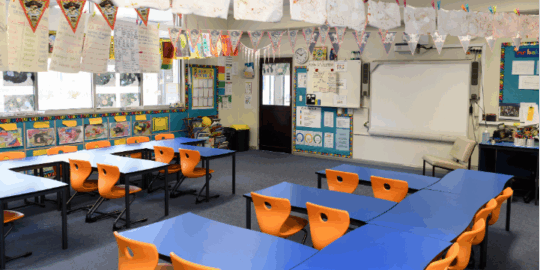
A World Economic Forum report estimates that 65% of children entering primary school today will ultimately enter occupations that do not currently exist. We have all learned to rely on technology, and learning is no different. Schools have the opportunity, and some would say obligation, to prepare students with relevant skills they will need for higher learning and jobs. This is why in a modern classroom, screen mirroring for education would be an essential edtech addition.
Technology is often seen as a part of the adult world and for kids’ entertainment, but now, more than ever, students need technology to assist their education. Career-wise, there is no question learners are heading into the unknown, but proper educational technology can help them prepare for the future.
Screen mirroring allows teachers and students to share their screen devices on a display. In addition to preparing them for the future, this technology increases their learning potential. It helps create a flexible teaching environment and enables the teacher to connect and collaborate with students while using technology.
It is schools, staff, and teachers who will ultimately provide the support and skills students will need on this uncharted journey. For this reason, more and more are embracing education technology, which has a wide range of already widely accepted benefits.
By using technology in the classroom, teachers can not only create engaging, student-centered activities to engage and retain students, but it also helps teachers become more organized and efficient. The result is better ROI on technology investments and improvement in student engagement.
The Value of Screen Mirroring for Education
Educators can use screen mirroring for education to teach from their devices from anywhere in the classroom, creating a more engaging experience for students and preparing them better for the future.
According to the National Center for Education Statistics, each year, the US spends nearly $706 billion on education, around $14,000 per student. Take off $10,000 per student to pay for the cost of teachers and administrators, and there’s not a huge amount left for edtech.
In 2019, MIT reported widespread excitement when spending on edtech passed $13 billion, which equates to just $255 for each of the country’s 51 million students. In a world where such technology is set to become as important to the classroom, it’s easy to understand why IT managers need to use their funds wisely.
However, in many cases, simply shifting where spending goes is enough. Every year, ineffective or aging technology drains a significant amount of school budgets in the form of maintenance, support, and equipment replacement, such as Ethernet, HDMI cables replacements, and damaged ports and connections.
The allure of shiny new, interactive flat panels for the classroom may be enticing, but the most cost-effective option is to retrofit aging monitors with screen-mirroring software. Not only will it revolutionize the learning environment, but the school district’s budget will benefit greatly from it. Investing in wireless technology is a smarter choice since it will increase accessibility and future-proof investments that have already been made.
Related: How classroom screen mirroring is the new norm
Considerations When Investing in Screen Mirroring for Education
Tighter school budgets might translate to limited functionality of a screen mirroring solution for education. According to Connected Mag, “Software solutions provide much more flexibility because they’re less reliant on bulky hardware and can evolve quickly, with new features delivered via software updates and maintenance taken care of remotely.
“But then, in the case of screen mirroring for education, a software-only product must rely on the ability of school and user-supplied hardware to facilitate connection. A better option for screen mirroring for education is the hybrid hardware/software model known as HESaaS or Hardware-Enabled Software as a Service.
“In this model, while there’s a hardware component that facilitates the system ‘on the ground,’ most of the technological intelligence is built into its software. This means that new features can be added via simple updates, the system can be scaled up as a school’s requirements change, and ongoing technical support can be delivered through a service relationship with the supplier.”
Considering this, what additional considerations should be taken into account?
Multipurpose Technology for Education
Solutions designed for education may come equipped with additional features such as collaborative benefits, formative assessment, health and wellbeing checks, fast and reliable video streaming, digital signage, emergency broadcast and more. Increasing the value of the investment.
Technology Adoption
For any technology to be successful in the classroom, there needs to be a clear benefit to those using it. One way to achieve this is for IT managers to involve teachers in buying decisions.
Partly, this is because not all teachers find it easy to adapt to the changing education landscape, particularly if the right professional development isn’t available to give them the confidence to embrace it.
Be certain about ROI
When considering an investment in technology, it’s important to make sure the solution is affordable, versatile, and will work with all the systems and displays the school uses.
For an investment in technology to remain relevant in today’s schools, it needs to build on the kind of participation, flexibility and collaboration with which mobile and networked devices have excited a whole generation. Implementing ineffective technology can result in $220 in costs per student if the wrong choice is made.
Improving engagement and learning outcomes
Research has shown that engaging students during the learning process increase their attention and focus, motivates them to think more critically, and promotes meaningful learning experiences.
Screen mirroring for education brings classrooms together in a way that would not have been possible just 10 years ago. It’s the power to start, stop and share and even cede control of what’s displayed on their screen, with everyone, from anywhere in the classroom. And that’s exciting for teachers, students, and administrators alike.
Related: Student engagement and academic performance
Benefits of Screen Mirroring for Education
“Wireless screen-mirroring can introduce new ways for instructors and students, teams, and meeting groups to communicate their ideas and collaborate on projects”, as explained by the IT department of the University of Miami.
Too often, school technology solutions that offer a good in-classroom experience fail to meet the needs of IT and administrators. The in-classroom experience of using a screen mirroring system is crucial, but it’s also important for the system to be easily managed at a school district level. This will not only ensure operational efficiency but also provide functionality that will improve learning outcomes.
Some of the benefits for IT managers are:
- Lower costs. Wireless screen mirroring can reduce the number of adapters used in a display system, which can reduce the cost of maintenance for institutions in the long run.
- Multiple users. Screen mirroring for education provides the ability for multiple users (instructors and students alike) to connect, which means fewer platforms to manage.
- Customer service. With central control the IT team knows of technical issues before the teacher gets into the room, providing a better service, even remotely.
- Metrics and dashboards. Analysis of student and teacher usage allows a better understanding of the rate of adoption of the system (which can turn into an ROI metric)
- Updates. Bulk software updates provide efficiency and school-wide consistency. Increasing the long-term profitability of an investment.
- Safety. Cloud-based management of the system at a device, room and district level gives school control over safe access and usage.
- Reliability. Integration video management, no latency, and robust in-classroom network performance significantly reduce IT tickets and support.
A highly affordable, compatible, and reliable solution is the most likely to be adopted, thus resulting in the greatest return on investment.Vivi is the only screen-mirroring solution dedicated solely to improving education outcomes. Request a demo and discover how technology systems are playing a pivotal role in educational budgets efficiency and unlocking the potential of the 21st Century students’ future.



